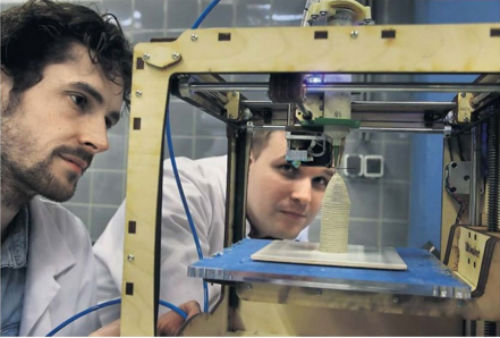
In Leeuwarden, students breathe new life into a natural material, clay. A ceramic water filter is produced after trial and error..
In the Water Application Centre (WAC) in Leeuwarden, two guys are staring at the nozzle of the Ultimaker, a home-built 3D printer. The students are testing the production of clay water filters, functioning as a ceramic membrane. Besides them, the bucket with failures in it is filling up nicely.
“Too wet, too dry, wrong shape, bubbles too big,” Tobias Strating says. He is a student of Environmental Science at VHL University of Applied Sciences. With his fellow student Geert Hobma, Strating developed the concept to be used in domestic households in countries lacking clean drinking water.
Most shapes look like a rather large thimble or a small, lean beehive. The baked product is supposed to end up at the bottom of a bucket of water, covering the hole where the tap is connected on the outside. When the tap is opened, the baked clay will let clean water pass, and stop bacterias and other types of pollution. If you add small scraps of silver and/or copper to the clay, even viruses are killed. Clay is an ideal material, because it is cheap, sustainable and it’s available almost anywhere.
It sounds simple, but the path to an attractive, affordable product for poor countries is filled with obstacles. Resistance could arise from cultural differences. “In many countries there is no understanding of clean or polluted drinking water. People don’t realise there is a connection between water and health or disease,” says teacher Leo Groendijk, who guides the students in their project. In a setting like that, a 3D printer salesman has a lot to explain. Sometimes the awareness is there, but people are satisfied with the solutions as they exist. “In many countries people are used to bags with water. For one third of a liter, you pay 10 euro cents. Extremely expensive, but they won’t switch over easily.”
Still, Strating doesn’t think a 3D printer is too ambitious. “You have to realise that a lot of technology is available in poor countries as well. Africa is filled with cars and mobile phones.”
He and Hobma can see clearly how entrepreneurial types will buy themselves a 3D printer and start their own business. “They are getting less expensive by the day, you can buy them for a few hundred euros now. Micro credits can be arranged for that.”
The African or Asian water entrepreneurs don’t have to do their own designing or programming. All printable files can be found on the internet, open source. Just a matter of downloading. A solar panel can provide the printer with power.
The students realise they can’t come up with and tackle every problem themselves. This year, a student from the African country Benin will get to work with the innovation. They hope he will come up with many practical challenges.
Photo caption: Tobias Strating and Geert Hobma closely watch the 3D printer producing a filter.
